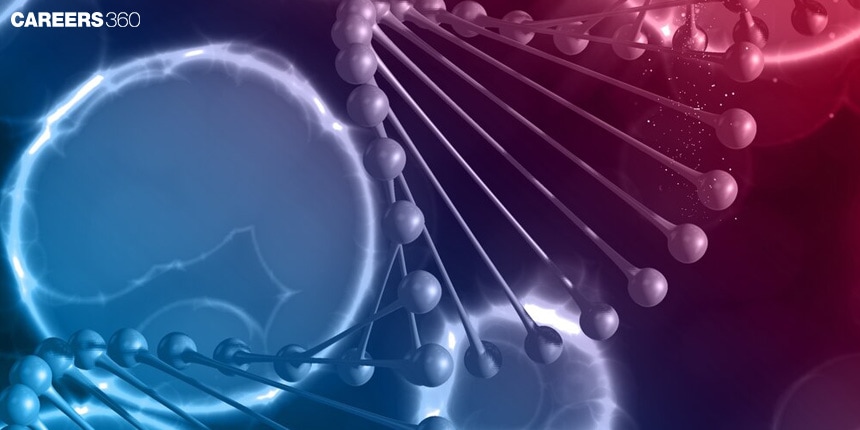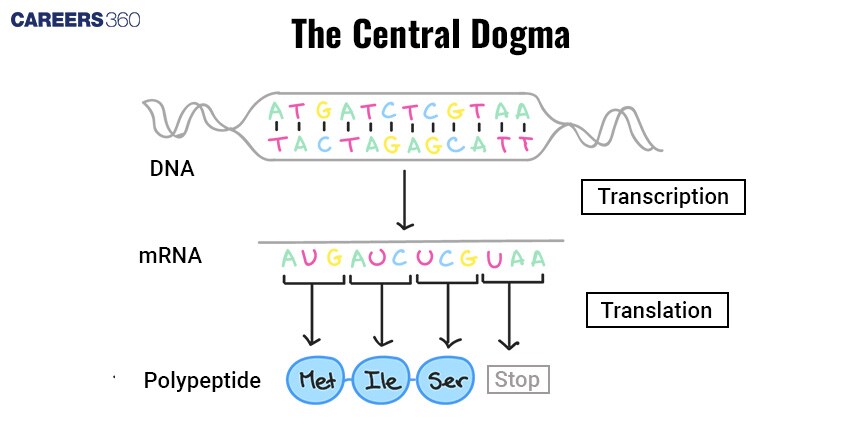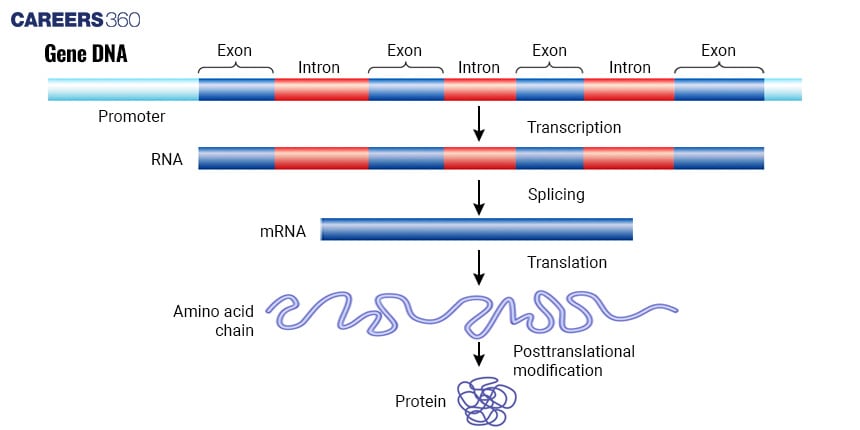Gene to Protein - Transcription and Translation
Transcription, Translation Of Molecular Biology
The central dogma of molecular biology represents a framework for conceptualizing the transfer of information, which occurs within a biological system, from one structural unit to another. First codified by Francis Crick in 1958, this distinguished scientist went on to explain how information initiates its throw from DNA to RNA and then into proteins. Recent elucidation of this key biological principle lies at the foundation of modern biology and explains the processes through which the genetic code contained within DNA is eventually transcribed into an active protein through an mRNA molecule.
Don't Miss: Most scoring concepts for NEET | NEET papers with solutions
NEET 2025: Syllabus | PYQs | Crack NEET in 2 months - Study Plan
NEET Important PYQ & Solutions: Physics | Chemistry | Biology | NEET PYQ's (2015-24)

Diagram: Replication, Transcription, Translation

The Role Of Gene Expression In Cellular Function
Gene expression is the process whereby information contained in DNA is transcribed into an active functional product, thereby considered as a protein or RNA molecule. This process is central to cellular function and organismal development. In this case, appropriate gene expression does take place in such a way that homeostasis within the cellular and organism levels is held. Diseases, examined by cancer, arise from misexpression of genes.
An Overview Of Transcription And Translation
There are two major ways genes are expressed: transcription and translation. In essence, transcription is the process whereby a section of DNA gets copied into RNA—more specifically, mRNA. Copies of the mRNA then move the genetic information from the nucleus out into the cytoplasm to its counterpart, the ribosomes, for translation. For that reason, the ribosome will read the mRNA to synthesize a polypeptide chain for a functional protein in the process of translation.
Definition Of A Gene
It is defined as the linear sequence of nucleotides in DNA coding for the formation of certain proteins or an RNA molecule. It is the fundamental level of inheritable unit found in chromosomes in the cell nucleus.
Structure Of The Gene Found On The Chromosome
Promoter: A DNA region where RNA polymerase binds to start the transcription.
Coding Sequence: Gene region from which RNA is transcribed, and later, portions where protein synthesis takes place.
Terminator: The nucleotide sequence signalling the end of transcription.
Diagram: Gene
Types Of Gene
Protein-coding Genes: Information in these genes is for making proteins.
Non-coding Genes: It does not code for proteins, but can otherwise produce functional RNA molecules such as ribosomal RNA and transfer RNA.
Gene To Protein
This flow of genetic information involves three major processes: replication, transcription, and translation.
Replication
Cellular conditions make a replica of the DNA molecule itself. This occurs just before the division of a cell so that, as the cell divides, each resulting cell will have a full complement of the genetic information of the parent cell.
Transcription
It refers to the process by which a gene is expressed. It refers to the formation of an RNA molecule for a gene. It is essentially carried out by RNA polymerases, which are enzymes.
Translation
In other words, translation is the synthesis of a protein from the mRNA transcript. A ribosome reads the sequence that occurs via mRNA, uses vitamins with the assistance of tRNA, and then synthesises a corresponding amino acid series that forms a polypeptide chain.
Transcription: From DNA To mRNA
Transcription is a process whereby RNA is created using a DNA template. The main purpose of the process is to enable the transfer of genetic paraphernalia from DNA to RNA, which can carry out the information for protein synthesis.
Transcription takes place in the eukaryotic nucleus and the cytoplasm of prokaryotic cells.
Initiation
The process is described as follows:
Role Of RNA Polymerase
RNA polymerase attaches to the DNA template and synthesises the RNA transcript—this process is termed RNA transcription.
Binding To The Promoter Region
RNA transcription is initiated by the binding of RNA polymerase at a special site on DNA called a promoter where this DNA sequence is called a gene.
Formation Of The Transcription Initiation Complex
The promoter region is the region at which the various transcription factors and RNA polymerases assemble to form a transcription initiation complex that starts the process of synthesising RNA.
In the process of elongation, the electron-microscopic structure of DNA is unwound by the RNA polymerase, giving the template strand of the DNA so that base-pairing with the RNA nucleotides can be achieved.
The RNA polymerase moves along the DNA template, adding RNA nucleotides that complement the DNA bases, which link to each other to form an mRNA molecule.
Role Of Transcription Factors
Transcription factors are proteins that assist the binding of RNA polymerase and initiate transcription
Termination
Termination in prokaryotes is brought about when the RNA polymerase transcribes a terminator sequence in the DNA; it is considerably more complex in eukaryotes, involving other proteins.
Transcription Termination
When the elongation process nears its end, the newly synthesized mRNA is released or terminated from RNA polymerase.
Post-transcriptional Modifications In Eukaryote
5' Capping
A transcription is initiated, and the 5' end of the mRNA is joined or capped with a modified guanine nucleotide that prevents the digestion of mRNA. It also has a significant role in ribosome binding to mRNA for translation.
Polyadenylation
The 3' end of mRNA is polyadenylated by the addition of a poly-A tail, which is believed to prevent degradation of the mRNA and also aids in the export of the mRNA from the nucleus.
Splicing
The non-coding regions (introns) are excised from the mRNA transcript and the coding regions (exons) are joined. This process is called splicing and a mature mRNA molecule is now ready for translation.
Translation: From mRNA To Protein
Translation is a precise process whereby the mRNA decoding pathway is used to translate a particular sequence of amino acids, which are induced to fold into a functional protein.
Location of the process
Translation takes place in the cytoplasm, in detail in the ribosomes.
mRNA (Messenger Ribonucleic Acid)
mRNA reads as the template for the synthesis of proteins. It translates the genetic information from DNA to the ribosome.
It is the specification in vivo of the amino acid sequence of polypeptide chains in the molecule of protein.
tRNA (Transfer RNA)
Molecules of this type carry amino acids to the ribosome and then learn the m-RNA anticodon that would match the code which is an encoded protein specifically.
Ribosomes (rRNA and Protein Complex)
The ribosomes, composed of rRNA and proteins, carry out the process by which the information contained in the mRNA molecule is used to build the protein.
Amino Acids
Building blocks of proteins are amino acids that are linked in a specific order that is encoded by the base sequence of the mRNA in the process of translation.
Recommended video for Transcription And Translation
The Genetic Code
The genetic code is a set of rules whereby information encoded within the genetic material—in the form of DNA or RNA sequences—is translated into proteins by living cells. It is universal for almost all organisms and consists of nucleotide triplets called codons. Each codon corresponds to one amino acid or one of the signals 'stop' while synthesizing the protein.
Codons and Anticodons
Triplets of nucleotides of mRNA that code for the amino acids. The sequence of three nucleotides on the mRNA, which codes for a particular amino acid. Anticodons are the triplets of nucleotides on the tRNA molecules that are complementary to codons.
Initiator And Terminator Codons
Translation initiates with an initiator codon (AUG) and terminates with a terminator codon (UAA, UAG, UGA).
Redundancy And Universality Of Genetic Code
The genetic code is degenerate in the sense that more than one triplet code can code for one amino acid. It is, however, universal for almost all organisms.
Translation Steps
The steps of translation have been discussed below:
Initiation
Initiation occurs when the small ribosomal subunit attaches to the mRNA and a special initiator tRNA.
The small subunit is associated with the large subunit.
Elongation
During elongation, tRNAs bring amino acids to the ribosome in the order prescribed by the mRNA codons.
The actual polypeptide is elongated by peptide bonds that form between the amino acid residues.
Termination
Translation stops when the ribosome reaches a stop codon.
The ribosome releases the completed polypeptide, which will spontaneously fold into its final, functional conformation.
Frequently Asked Questions (FAQs)
Transcription is the process in which a copy of the gene's DNA sequence is made into a complementary mRNA; translation is the process by which mRNA is translated into a protein.
The steps involved are initiation, elongation, and termination, with post-transcriptional modifications taking place in eukaryotes.
The genetic code consists of the codons of the mRNA, which specify the amino acids of the protein. It is universal and redundant.
The former occurs in the cytoplasm of prokaryotes, and those processes are not as complex as eukaryotic ones while the mechanisms controlling them differ.
Mutations alter the DNA sequence; hence, they cause changes in the processes of transcription and translation, which might lead to an occurrence of sickness.
Also Read
29 Nov'24 09:31 AM
19 Nov'24 09:26 AM
18 Nov'24 06:45 PM
18 Nov'24 09:29 AM
18 Nov'24 09:18 AM
18 Nov'24 09:01 AM
18 Nov'24 08:37 AM
16 Nov'24 03:45 PM
